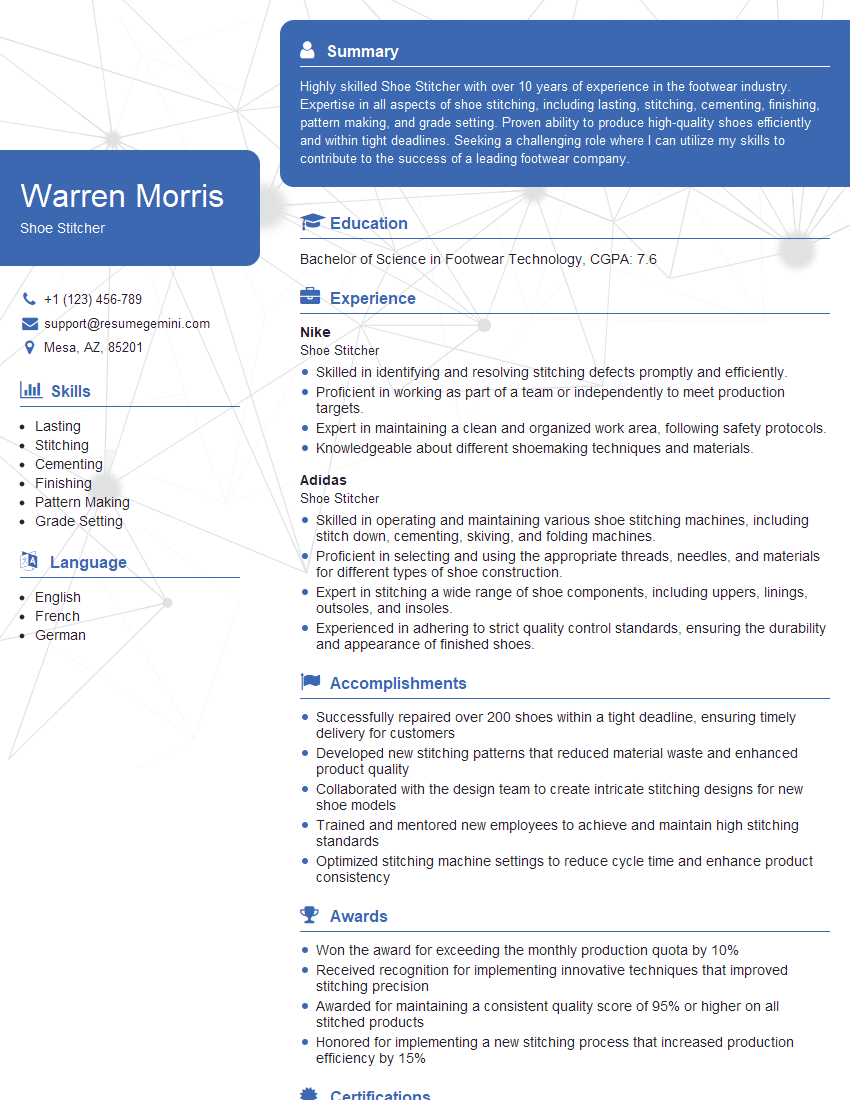Are you a seasoned Shoe Stitcher seeking a new career path? Discover our professionally built Shoe Stitcher Resume Template. This time-saving tool provides a solid foundation for your job search. Simply click “Edit Resume” to customize it with your unique experiences and achievements. Customize fonts and colors to match your personal style and increase your chances of landing your dream job. Explore more Resume Templates for additional options.

Warren Morris
Shoe Stitcher
Summary
Highly skilled Shoe Stitcher with over 10 years of experience in the footwear industry. Expertise in all aspects of shoe stitching, including lasting, stitching, cementing, finishing, pattern making, and grade setting. Proven ability to produce high-quality shoes efficiently and within tight deadlines. Seeking a challenging role where I can utilize my skills to contribute to the success of a leading footwear company.
Education
Bachelor of Science in Footwear Technology
February 2017
Skills
- Lasting
- Stitching
- Cementing
- Finishing
- Pattern Making
- Grade Setting
Work Experience
Shoe Stitcher
- Skilled in identifying and resolving stitching defects promptly and efficiently.
- Proficient in working as part of a team or independently to meet production targets.
- Expert in maintaining a clean and organized work area, following safety protocols.
- Knowledgeable about different shoemaking techniques and materials.
Shoe Stitcher
- Skilled in operating and maintaining various shoe stitching machines, including stitch down, cementing, skiving, and folding machines.
- Proficient in selecting and using the appropriate threads, needles, and materials for different types of shoe construction.
- Expert in stitching a wide range of shoe components, including uppers, linings, outsoles, and insoles.
- Experienced in adhering to strict quality control standards, ensuring the durability and appearance of finished shoes.
Accomplishments
- Successfully repaired over 200 shoes within a tight deadline, ensuring timely delivery for customers
- Developed new stitching patterns that reduced material waste and enhanced product quality
- Collaborated with the design team to create intricate stitching designs for new shoe models
- Trained and mentored new employees to achieve and maintain high stitching standards
- Optimized stitching machine settings to reduce cycle time and enhance product consistency
Awards
- Won the award for exceeding the monthly production quota by 10%
- Received recognition for implementing innovative techniques that improved stitching precision
- Awarded for maintaining a consistent quality score of 95% or higher on all stitched products
- Honored for implementing a new stitching process that increased production efficiency by 15%
Certificates
- Certified Shoe Stitcher
- Lean Six Sigma
- ISO 9001
- OSHA Safety Certification
Career Expert Tips:
- Select the ideal resume template to showcase your professional experience effectively.
- Master the art of resume writing to highlight your unique qualifications and achievements.
- Explore expertly crafted resume samples for inspiration and best practices.
- Build your best resume for free this new year with ResumeGemini. Enjoy exclusive discounts on ATS optimized resume templates.
How To Write Resume For Shoe Stitcher
- Highlight your skills and experience in your resume summary.
- Use keywords related to the shoe stitching industry in your resume.
- Provide specific examples of your accomplishments in your work experience section.
- Proofread your resume carefully before submitting it.
Essential Experience Highlights for a Strong Shoe Stitcher Resume
- Lasting and stitching shoes according to specified patterns and designs.
- Cementing soles to uppers and ensuring a secure bond.
- Finishing shoes by trimming excess material, sanding, and polishing.
- Making patterns and grading them for different sizes.
- Setting up and operating stitching machines.
- Maintaining a clean and organized work area.
- Inspecting shoes for quality and ensuring they meet customer specifications.
Frequently Asked Questions (FAQ’s) For Shoe Stitcher
What are the different types of shoe stitching machines?
There are many different types of shoe stitching machines, each designed for a specific task. Some of the most common types include lasting machines, stitching machines, cementing machines, and finishing machines.
What are the different materials used in shoe stitching?
The most common materials used in shoe stitching are leather, fabric, and rubber. Other materials, such as synthetics and plastics, are also sometimes used.
What are the different types of shoe stitching techniques?
There are many different shoe stitching techniques, each with its own advantages and disadvantages. Some of the most common techniques include hand stitching, machine stitching, and cemented stitching.
What are the different quality standards for shoe stitching?
There are a number of different quality standards for shoe stitching, depending on the intended use of the shoes. Some of the most common standards include ASTM D3190, ISO 21185, and SATRA TM172.
What are the different safety precautions that should be taken when working with shoe stitching machines?
There are a number of different safety precautions that should be taken when working with shoe stitching machines. Some of the most important precautions include wearing eye protection, ear protection, and gloves. It is also important to keep the work area clean and free of clutter.
What are the different career opportunities for shoe stitchers?
There are a number of different career opportunities for shoe stitchers. Some of the most common opportunities include working in a shoe factory, a shoe repair shop, or a custom shoemaker shop.
What are the different training programs available for shoe stitchers?
There are a number of different training programs available for shoe stitchers. Some of the most common programs are offered by vocational schools, community colleges, and trade unions.
What are the different certifications available for shoe stitchers?
There are a number of different certifications available for shoe stitchers. Some of the most common certifications are offered by the American Society of Shoemakers and the International Association of Shoemakers.